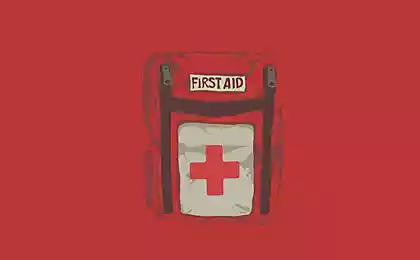558
The aralia is an effective biostimulator
The aralia (the name in Latin. Aralia mandshúrica) has other names: aralia high, the damn tree and thorn-tree.
Species and family of plants: Aralia is a fast growing shrub or small deciduous tree. The plant is a species of the genus Aralia, family Araliaceae. The genus name in Latin Aralia, family Araliaceae.

Botanical karakteristieken (rhizome): the location of the root system of aralia radial. They are arranged horizontally from the earth's surface at a depth of 10-25 cm and Then, at a distance of 2-3 (sometimes 5) meters from the trunk, the roots of the plants cool bent vertically downward to a depth of 50-60 centimeters. They are abundantly branched and form many branches.
The trunk (stem): stem straight, whose diameter is about 20 centimeters. The trunk of the tree and its branches covered with a large number of large spikes.
Leaves: large, their length up to 1 m and even more. Leaves dvazhdyperistye complex, they consist of 2-4 lobes of the first order, and those in turn are composed of 5-9 pairs of leaflets.
The flowers and buds: small, cream or white, bisexual, clustered in umbels forming large many-flowered branching inflorescence at the top of the barrel. The inflorescence consists of 50-70 thousand flowers. The diameter of the inflorescence to 45 cm.
Fruits: fruiting annual and sustainable. Fruits are blue-black, agrobrite, inside have 5 pits, whose diameter is up to 5 mm. Adult araliya to 60 thousand fruit can form. The weight of one thousands of fruits will be about 50 grams.
Height: the height of the plant will dotiruet 6, sometimes 12 meters.
Flowering time: aralia blooms in July-August. In natural conditions begins to bloom in the fifth year of life. Flowers begin to bloom from the edges.
Ripening time: second half of September—October.
Lifespan: Actively developing aralia up to 22-24 years, then the processes of growth begin to fade.
Reproduction: aralia well expressed the ability to reproduce vegetatively. But also multiply and seeds. Adventitious buds on the roots meter 1 may be formed up to 250 pieces of them formed shoots. After the freezing or cutting of aralia, she starts to give a thick growth.
Distribution: araliya high prevalent in Korea, Japan and China in the far East, the Kuril Islands, Sakhalin, Primorsky Krai.
Araliya is growing high single or in small groups in the undergrowth of coniferous and mixed forests. The plant prefers a light place, forest edges and clearings.
What part of the plant used: medicinal raw material from aralia are the roots, leaves and bark. The fruits of aralia are used.
The chemical composition of plants: the roots of aralia contain alkaloids, carbohydrates, triterpene saponins, volatile oil, flavonoids, organic acids, resinous substances.
Picking and harvesting siranli the roots are harvested in autumn, then start to do it in September, but if in the spring, before new leaves are coming out. Digging should start from the trunk and gradually moving to the periphery of the root. Suitable for raw roots, with a thickness of 1-3 cm. If the diameter is less than 1 cm or more 3 cm, these roots are not dug up. When the workpiece can not have plants to dig up its entire root system. You need to leave at least half the roots, which depart radially from the trunk. It has many adventitious buds, which, after the blanks will provide the restoration of thickets of aralia.
The place the dug plants are recommended to plant the root stalk of the plant, a length of about 10 cm in diameter 1-3 cm is Recommended to use for harvesting plants aged 5-15 years.
Dug the roots are cleaned from the ground, while this removes the roots that have decayed or blackened Central part, and the roots, whose diameter is more than 3, see the roots Dried in the dryer, do not raise temperature above 50 °C, or in the premises, but then they have to be well ventilated. If the weather is dry, you can do it outdoors. Raw aralia suitable 2 years. The raw materials fragrant smell and a bitter, slightly astringent taste.
The bark of aralia is going at the same time as the roots. The leaves are collected during or after flowering, in Sunny dry weather. Leaves and bark are dried at a temperature of 50 — max 55 °C.
Traditional medicine also uses other types of aralia — Schmidt, continental.
Pharmacological properties (Effects)Herbal medicines on the basis of aralia stimulant effect on the Central nervous system. According to the activity they surpass the effect of preparations of Eleutherococcus and ginseng. The root extract of aralia marked gonadotropic effect. On blood pressure preparations from aralia significant influence, slightly stimulate breathing and have some cardiotonic effect. Drugs of aralia are also characterized and antistress action.
The use of aralia manchzhurskaya. They make the drug "Saparal". Tincture to stimulate the Central nervous system, asthenia and hypotension. Offered in clinics for mental and physical fatigue, impotence, early stages of atherosclerosis, in schizophrenia and postgrippoznyh arachnoiditis.
In folk medicine used a decoction for diabetes, gastrointestinal diseases, inflammation of the mouth, colds, diseases of the liver and kidneys, bedwetting, and as a means of strengthening character. Japanese medicine uses a decoction of diabetes and an illness. In the far East, enuresis, colds, flu; Nanai is used for stomatitis, toothache, liver diseases and as a tonic.
Bark, roots and leaves. Make a decoction in diseases of the digestive tract, kidneys, diabetes.
Recipes and method of application of aralia manchzhurskaya the roots of aralia (roots 1 part:5 parts of alcohol) in 70% alcohol. Insist 2 weeks, then strain and squeeze. The finished tincture aralia amber color, the taste is quite pleasant and a peculiar odor. Inside administered 35 drops in the first half of the day, 2-3 times a day, for one month. But if a person observed a tendency to increased pressure, it is necessary to reduce the dosage to 10 drops and up to two times daily.
Shown tincture aralia when astenodepressivnyh States, patients after severe chronic diseases in the stage of convalescence, hypotension, impotence, mental and physical fatigue. Tincture positive effect on patients that are prone to the asthenic syndrome after influenza. The positive effect is achieved three times faster than from medication.
Contraindications to the infusion: for insomnia, high nervous excitability, hypertension.
There is still saparal drug derived from the roots of aralia. Latin is called Saparalum. It has small toxicity. Has a relatively low hemolytic index, side effects with prolonged use not cause. This medication is close by aralia on obsevatory action.
Studies have shown that saparal refers to a CNS stimulant desynchronizing action. Prescribed to take after meals or 1 tablet 2-3 times a day. The treatment course two weeks to a month. Repeated courses after a one — or two-week break.
Contraindications to caparulo: hypertension, hyperkinesis, epilepsy, anxiety. In the evening hours is not recommended, as it can disrupt night sleep.
A decoction of the roots of aralia. Need 20 gr. crushed roots pour 200 ml of hot water. In a sealed container (enamel), water bath boil for half an hour. At room temperature to cool for 10 minutes, then drain, squeeze, and clean water to dilute, bring to the original volume. In the refrigerator for 3 days to store. Taken three times per day before meals tablespoon. The treatment course is 2-3 weeks.
This decoction is effective for gastrointestinal diseases, diabetes, colds, perfectly removes inflammation in the oral cavity, bedwetting cures, can be applied as a tool for General strengthening. The decoction showed effective in kidney disease.
Kalman — the so-called tonic, which can be prepared from aralia. It is soft and somewhat reminiscent of Coca-Cola.
Young leaves of aralia in the quality of feed to give to cattle, and eaten boiled or fried.
Protivopokazaniya seen from the contraindications to the drugs aralia listed above, they have common points. This hypertension, epilepsy, insomnia, high nervous excitability, hyperkinesis. Still not recommended to exceed the dosage of these drugs and take them the evening, closer to sleep.
Source: lubim-zhizn.ru/
Species and family of plants: Aralia is a fast growing shrub or small deciduous tree. The plant is a species of the genus Aralia, family Araliaceae. The genus name in Latin Aralia, family Araliaceae.

Botanical karakteristieken (rhizome): the location of the root system of aralia radial. They are arranged horizontally from the earth's surface at a depth of 10-25 cm and Then, at a distance of 2-3 (sometimes 5) meters from the trunk, the roots of the plants cool bent vertically downward to a depth of 50-60 centimeters. They are abundantly branched and form many branches.
The trunk (stem): stem straight, whose diameter is about 20 centimeters. The trunk of the tree and its branches covered with a large number of large spikes.
Leaves: large, their length up to 1 m and even more. Leaves dvazhdyperistye complex, they consist of 2-4 lobes of the first order, and those in turn are composed of 5-9 pairs of leaflets.
The flowers and buds: small, cream or white, bisexual, clustered in umbels forming large many-flowered branching inflorescence at the top of the barrel. The inflorescence consists of 50-70 thousand flowers. The diameter of the inflorescence to 45 cm.
Fruits: fruiting annual and sustainable. Fruits are blue-black, agrobrite, inside have 5 pits, whose diameter is up to 5 mm. Adult araliya to 60 thousand fruit can form. The weight of one thousands of fruits will be about 50 grams.
Height: the height of the plant will dotiruet 6, sometimes 12 meters.
Flowering time: aralia blooms in July-August. In natural conditions begins to bloom in the fifth year of life. Flowers begin to bloom from the edges.
Ripening time: second half of September—October.
Lifespan: Actively developing aralia up to 22-24 years, then the processes of growth begin to fade.
Reproduction: aralia well expressed the ability to reproduce vegetatively. But also multiply and seeds. Adventitious buds on the roots meter 1 may be formed up to 250 pieces of them formed shoots. After the freezing or cutting of aralia, she starts to give a thick growth.
Distribution: araliya high prevalent in Korea, Japan and China in the far East, the Kuril Islands, Sakhalin, Primorsky Krai.
Araliya is growing high single or in small groups in the undergrowth of coniferous and mixed forests. The plant prefers a light place, forest edges and clearings.
What part of the plant used: medicinal raw material from aralia are the roots, leaves and bark. The fruits of aralia are used.
The chemical composition of plants: the roots of aralia contain alkaloids, carbohydrates, triterpene saponins, volatile oil, flavonoids, organic acids, resinous substances.
Picking and harvesting siranli the roots are harvested in autumn, then start to do it in September, but if in the spring, before new leaves are coming out. Digging should start from the trunk and gradually moving to the periphery of the root. Suitable for raw roots, with a thickness of 1-3 cm. If the diameter is less than 1 cm or more 3 cm, these roots are not dug up. When the workpiece can not have plants to dig up its entire root system. You need to leave at least half the roots, which depart radially from the trunk. It has many adventitious buds, which, after the blanks will provide the restoration of thickets of aralia.
The place the dug plants are recommended to plant the root stalk of the plant, a length of about 10 cm in diameter 1-3 cm is Recommended to use for harvesting plants aged 5-15 years.
Dug the roots are cleaned from the ground, while this removes the roots that have decayed or blackened Central part, and the roots, whose diameter is more than 3, see the roots Dried in the dryer, do not raise temperature above 50 °C, or in the premises, but then they have to be well ventilated. If the weather is dry, you can do it outdoors. Raw aralia suitable 2 years. The raw materials fragrant smell and a bitter, slightly astringent taste.
The bark of aralia is going at the same time as the roots. The leaves are collected during or after flowering, in Sunny dry weather. Leaves and bark are dried at a temperature of 50 — max 55 °C.
Traditional medicine also uses other types of aralia — Schmidt, continental.
Pharmacological properties (Effects)Herbal medicines on the basis of aralia stimulant effect on the Central nervous system. According to the activity they surpass the effect of preparations of Eleutherococcus and ginseng. The root extract of aralia marked gonadotropic effect. On blood pressure preparations from aralia significant influence, slightly stimulate breathing and have some cardiotonic effect. Drugs of aralia are also characterized and antistress action.
The use of aralia manchzhurskaya. They make the drug "Saparal". Tincture to stimulate the Central nervous system, asthenia and hypotension. Offered in clinics for mental and physical fatigue, impotence, early stages of atherosclerosis, in schizophrenia and postgrippoznyh arachnoiditis.
In folk medicine used a decoction for diabetes, gastrointestinal diseases, inflammation of the mouth, colds, diseases of the liver and kidneys, bedwetting, and as a means of strengthening character. Japanese medicine uses a decoction of diabetes and an illness. In the far East, enuresis, colds, flu; Nanai is used for stomatitis, toothache, liver diseases and as a tonic.
Bark, roots and leaves. Make a decoction in diseases of the digestive tract, kidneys, diabetes.
Recipes and method of application of aralia manchzhurskaya the roots of aralia (roots 1 part:5 parts of alcohol) in 70% alcohol. Insist 2 weeks, then strain and squeeze. The finished tincture aralia amber color, the taste is quite pleasant and a peculiar odor. Inside administered 35 drops in the first half of the day, 2-3 times a day, for one month. But if a person observed a tendency to increased pressure, it is necessary to reduce the dosage to 10 drops and up to two times daily.
Shown tincture aralia when astenodepressivnyh States, patients after severe chronic diseases in the stage of convalescence, hypotension, impotence, mental and physical fatigue. Tincture positive effect on patients that are prone to the asthenic syndrome after influenza. The positive effect is achieved three times faster than from medication.
Contraindications to the infusion: for insomnia, high nervous excitability, hypertension.
There is still saparal drug derived from the roots of aralia. Latin is called Saparalum. It has small toxicity. Has a relatively low hemolytic index, side effects with prolonged use not cause. This medication is close by aralia on obsevatory action.
Studies have shown that saparal refers to a CNS stimulant desynchronizing action. Prescribed to take after meals or 1 tablet 2-3 times a day. The treatment course two weeks to a month. Repeated courses after a one — or two-week break.
Contraindications to caparulo: hypertension, hyperkinesis, epilepsy, anxiety. In the evening hours is not recommended, as it can disrupt night sleep.
A decoction of the roots of aralia. Need 20 gr. crushed roots pour 200 ml of hot water. In a sealed container (enamel), water bath boil for half an hour. At room temperature to cool for 10 minutes, then drain, squeeze, and clean water to dilute, bring to the original volume. In the refrigerator for 3 days to store. Taken three times per day before meals tablespoon. The treatment course is 2-3 weeks.
This decoction is effective for gastrointestinal diseases, diabetes, colds, perfectly removes inflammation in the oral cavity, bedwetting cures, can be applied as a tool for General strengthening. The decoction showed effective in kidney disease.
Kalman — the so-called tonic, which can be prepared from aralia. It is soft and somewhat reminiscent of Coca-Cola.
Young leaves of aralia in the quality of feed to give to cattle, and eaten boiled or fried.
Protivopokazaniya seen from the contraindications to the drugs aralia listed above, they have common points. This hypertension, epilepsy, insomnia, high nervous excitability, hyperkinesis. Still not recommended to exceed the dosage of these drugs and take them the evening, closer to sleep.
Source: lubim-zhizn.ru/























